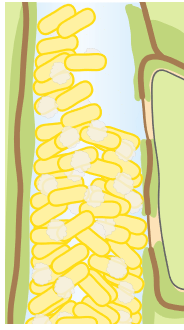Teaching
In the lab, we build our experiments from established protocols. To make it easier for colleagues to build courses, I am sharing the teaching materials I developed for a new class at UC Davis.
PLP100 Biology of Plant Pathogens Curriculum (undergraduate course)
This course uses a modular structure to provide students with deep understanding of 8 diverse plant pathogens. Each week, the instructor gives a lecture that covers the evolutionary neighborhood, ecology, life cycle, infection process, and specific molecular biology mechanisms of the pathogen/pathogen group. Students they read papers through the collaborative Perusall website for homework. Then students work in small groups to describe the motivation, approach, and how the figures/table convey results of a subset of figures.
Documents
- Course Administration document (Syllabus)
- Perusall Scoring Settings
- Guidelines for Paper Discussions
- Guidelines for Partner Presentations
Lectures
Lectures are designed such that I teach the material at the rate that students can learn it. Instead of using a chalkboard/white board, I design powerpoint slide decks that are partial outlines. Students are advised to bring a digital or printed copy of the notes. In class, I use a stylus + touchscreen laptop to annotate the slides while I teach the concepts.
Example of a slide:

Student Handouts
This repository only includes the Student Handouts. I am willing to share the Instructor Note versions by email.
- Ralstonia
- Xylella
- Xanthomonas
- Aspergillus. This was a weaker lecture than the others. I wanted to improve it before teaching it, but it was the first lecture in “hybrid” mode after 3 weeks of online class.
- Fusarium graminearum
- Phytophthora
- Banana Streak virus
- Cassava Brown streak virus. Note: I think that I included outdated & inaccurate information about the specifics of the vector transmission biology.
Paper discussions
To prepare students to adopt a Growth Mindset / Beginner’s Creed and introduce them to best practices in reading papers, I assign 3 readings in the first week:
- The Beginner’s Creed By Peter J. Denning
- Ten simple rules for reading a scientific paper. Carey et al. 2020
- Fixed Mindset vs. Growth Mindset Examples By Ashley Cullin
Then, each pathogen lecture was paired with a scientific paper on the topic. I tried to select papers that seemed accessible (i.e. ones that I thought I could understand by skimming the figures) and that reflected the breadth of the field of plant pathology (basic, applied, epidemiology/management, population genetics/genomics, functional genomics, cell biology, genetics, physical/chemical interfaces of pathology, etc.).
Papers
I created a Crowd-Sourcing Plant Pathology Papers for Teaching database, which includes the 8 papers that were discussed in PLP100 in Winter 2022. If you have suggestions for papers to teach in plant pathology classrooms, plase add them to the database via this Google Form
Approach
Students read the research papers on the Perusall platform. In class, I divided them into groups of 3-4 and assigned each group a subset of figure panels to understand. They were tasked with identifying the “motivation”, the “experimental approach”, and “how the figures convey the results”. I provided a skeleton “Google Presentation” that each group could annotate. After ~40 minutes, I would bring the class back together and each group would present their figure to the class.
Credits
Inspiration for class format came from Cameron Tyson’s Organic Chemistry course (Georgia Tech) and the Microbiology Teaching Fellows Mic305 curriculum. Additionaly ideas came from Cooper Battle at Willamette University and Shawna Reed at Quinnipiac University.
